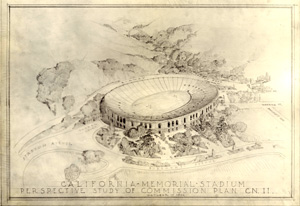UC Berkeley Web Feature
California Memorial Stadium
BERKELEY – California Memorial Stadium, completed in November 1923, is dedicated to University of California, Berkeley students, alumni and other Californians who lost their lives in World War I. Situated in Strawberry Canyon, it remains one of the most beautiful settings in college athletics.
 This sketch of the planned California Memorial Stadium was made in October 1922, just two months before construction got underway. (Courtesy the Bancroft Library) |
When a plan to build a stadium was first conceived, the university's athletics program was run by the Associated Students of the University of California. To finance the original stadium construction, a subscription drive was launched in October 1921. For each $100 donated, the subscriber received scrip that could be used to buy two Cal-Stanford Big Game tickets at $5 each for the next 10 years.
Alumni, faculty, students and fans responded immediately. In no time the first $800,000 was raised.
The total construction cost was $1.4 million. UC Comptroller Robert Gordon Sproul (who in 1930 would become UC president) noted at the time that the fundraising effort made it possible to build the stadium "without the expenditure of one cent of university funds or state appropriations."
Construction began in December 1922, and 11 months later, Memorial Stadium opened in time for the 1923 Big Game. The game drew 73,000 fans and is reported to have been the largest crowd up to that day to witness a football game in the West. Cal won, 9-0.
Designed by John Galen Howard, with co-designers G.F. Buckingham and E.E. Carpenter, the stadium is modeled after the Colosseum in Rome. It is framed by the pine trees of the Berkeley Hills to the east and panoramic views of the campus and San Francisco Bay to the west.
On the day of the stadium's dedication, Sproul declared: "Deep rooted in the eternal hills, this memorial to the honored dead, here devoted to the service of the living, raises its noble crown into the clear California sky and stands in simple dignity, beauty and strength."

